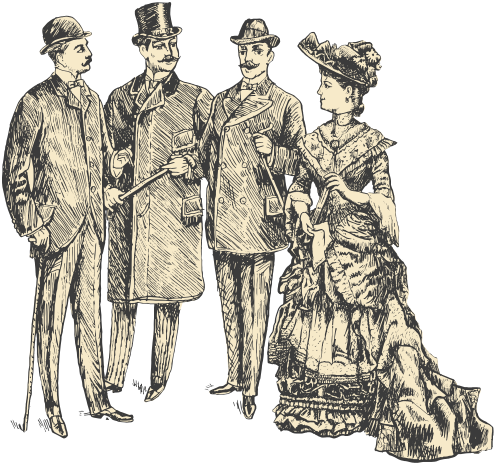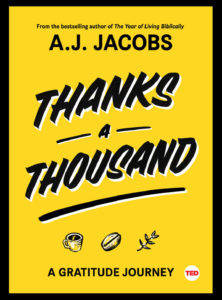Saying Thanks Is Good for Business
Our newest virtual game, A World of Thanks: The Gratitude Scavenger Hunt, is all about focusing on the positive: in our lives, in the world around us, and throughout history. It’s a virtual thanks-giving game that brings colleagues together on a hunt around the world for pioneering people, natural wonders, and wonderful inventions. Contact us to learn more and schedule your group’s private Gratitude Scavenger Hunt.
In that spirit, author A.J. Jacobs joins us to reflect on the value of gratitude:
Thank you for reading this sentence. Thank you for considering these suggestions below. Thank you for being a fan of Watson Adventures. Thank you, thank you, thank you.
Okay, perhaps that’s a bit over the top.
But I’ve become quite the fan of gratitude. Saying thanks isn’t just a nice thing your mother taught you to do – it’s one of the most powerful tools in business. It helps with customers, clients, morale, and team building.
I’m an author who happens to be married to Julie Jacobs, the chief development officer at Watson Adventures. And I learned about the power of gratitude while writing my book Thanks a Thousand: A Gratitude Journey.
For the book, I travelled the globe and personally thanked everyone who had even the smallest role in making my morning cup of coffee a reality. So I thanked the barista and the coffee bean farmer, of course. But I also thanked the logo designer, the HR folks at the coffee company, the driver of the coffee bean truck, the folks who made the pavement for the road where the truck driver travelled. In the end, it was a LOT of people. More than a thousand.
The project was an excellent reminder that we take for granted the hundreds of things that go right every day and focus on the three or four that go wrong. It also taught me lessons in the most effective way to thank. For instance, a study from Wharton business school suggests that the phrase “thank you” is less effective than another phrase: “I’m really grateful.” This is because the phrase “thank you” is seen as knee-jerk. So I tried to mix up my gratitude phrasings.
And I got a crash course in how important gratitude is in a successful business. There is tons of research on this. Here are some examples.

Author and gratitude expert A.J. Jacobs
Gratitude helps with getting and keeping customers
The software company Wufoo recently sent handwritten thank you cards to about 800 customers. The company reported that retention rates were 50 percent higher for those who got a note. (Thanks to the blog “Develop Good Habits” for alerting me to this).
I’ve had my own experience handwriting notes to customers. To celebrate the publication of my book, I announced that I would send 1,000 handwritten, personalized notes to readers of my books and articles.
It has turned out to be, a) a huge pain in the butt/hand, and b) absolutely wonderful. I set up a page on my website on which readers could tell me their name, address – and any information they want me to know to help me personalize my notes. It could be that they love the Seattle Seahawks, or that they’re infatuated with the Jolly Green Giant (which is fine, who am I to judge?)
The feedback forms have been fascinating, moving and sometimes delightfully weird. I’ve been asked to write thank you notes to dogs and ex-wives. One reader asked me to draw a taco – not sure why, but I gave it my best shot. Importantly, I learned what parts of my books have resonated with readers. My wife is a big hit, it seems. I need to write more about my wife.
And though it’s taken me many nights, and I’m not finished, writing the notes gives me a little dopamine boost. That’s one wonderful part of gratitude. When it works best, it should bring joy to both the thankee and the thanker.
Gratitude helps with company morale
Doug Conant, the former CEO of Campbell’s Soup, says he wrote 10 to 20 handwritten notes to employees every day for the decade he was at the helm of the $2 billion company. That adds up to more than 30,000 handwritten notes in his career. He credits the notes with helping him turn the company around.
The leaders of SoulCycle, the fitness company, foster a culture of gratitude. Employees are given a 10-pack of pins, and are encouraged to give a pin to colleagues to whom they’re grateful. (Thanks to Erica Keswin for writing about this in her book Take Your Human to Work Day.)
And another company – a travel community called Indagare – starts every workday with a voluntary gratitude ritual. Those who are interested can join a morning meeting where participants go around the table and say one thing they are thankful for.
Gratitude helps with getting a job
Harvard professor Francesca Gino conducted a study about whether a simple note saying “Thank you so much! I’m really grateful!” would increase response rates when job seekers asked an informational interview. It did. It doubled them, from 33 percent to 66 percent.
I’m biased, so when it comes to team building and morale, I still think that nothing beats a fun and intellectually-challenging gratitude scavenger hunt. But perhaps gratitude rituals are the next best thing.
A. J. Jacobs is the editor of ‘What It Feels Like’ and the author of best-selling books as ‘The Know-It-All’ and ‘The Year of Living Biblically.’ He is the senior editor of Esquire and has written for the New York Times, Entertainment Weekly, Glamour, New York magazine, New York Observer, and other publications.

